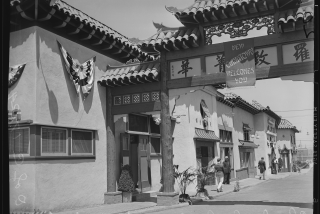Pain, fear and longing: memories of Angel Island
The photograph that changed Charles Wong’s life went on display Friday at the Chinese American Museum in Los Angeles. It is a small black-and-white portrait of a somber woman, a little boy in a new suit and a handsome youth on the cusp of manhood.
Wong found the family portrait — his family portrait — tucked in a suitcase, hidden in a closet, on the day his father, Gun Chown Wong, was buried. The woman in the photo was his mother, Jook Sue. The boy was Wong himself, 6 and scared. And the young man? He was the family secret.
FOR THE RECORD:
Chinese immigrants: A story that ran July 19 in the LATExtra section about early Chinese immigrants to the U.S. noted that one individual, Jook Sue, who was traveling from Hong Kong, was granted permission to fly west. The story should have said that Sue was granted permission to fly to the West from Hong Kong. —
In 1935, Gun Chown boarded the U.S. liner Coolidge and headed to Los Angeles, leaving his family behind in the Chinese village of Hoi-Seun. His first stop was Angel Island, the notorious immigration station in San Francisco Bay, which processed more than a million immigrants before closing in 1940.
By the time the Wong family could afford to reunite, Angel Island was history. So Jook Sue took her two sons to Hong Kong. That was where the portrait was taken, where she was interviewed repeatedly by immigration officials, where she was finally granted permission to fly west.
Charles was allowed to go with his mother. But Liang, 18, was denied entry. Forced to stay behind, he eventually jumped to his death from a five-story building. His family never spoke of him again.
Until Wong found the portrait, “I didn’t know I had a brother. I had suppressed his memory,” he recalled, as he wandered the Chinese American Museum, where workers were busy installing a new exhibit called “Remembering Angel Island.”
“Our story is representative of Angel Island, of the possibility, of the difficulty and traumas that many others went through,” said Wong, now 62, as he spoke of immigration’s effect on his life, of his mother’s depression, his father’s silence, his own ongoing survivor’s guilt. “It was not just our family.”
The immigration station opened 100 years ago, and the exhibit highlights the stories of Angelenos who entered America through its doors. “Remembering Angel Island” is on view through May 29.
There are photos of the station’s cramped quarters and dining halls, reproductions of poems that were etched on the walls by Chinese immigrants aching for home and fearing the future. The passport of 9-year-old Florence See is on display; a U.S. citizen, she was still detained and interrogated. See was the great-aunt of Los Angeles author Lisa See.
Actor Jack Ong created an installation in honor of his mother, Jeung Shee Ong, who fled Japanese troops in 1939 with five children in tow. She made it to Hong Kong, then sailed to America aboard the Coolidge only to languish for more than a month on Angel Island, according to the exhibit, “terrified of the ghosts of those who committed suicide in the barracks rather than face deportation back to China.”
Angel Island is often described as the Ellis Island of the west. But Pauline Wong, executive director of the Chinese American Museum, is quick to point out that most immigrants processed in New York Harbor were quickly sent on their way, while those who came through the California facility were often held for weeks, months, even years.
Opened after the passage of the Chinese Exclusion Act, it became the physical symbol of America’s aggressive policies. Although immigrants from more than 80 countries spent time on the inhospitable island, Chinese immigrants arrived in greater numbers, were detained longer and deported more often than Europeans.
“The Angel Island experience is a very painful chapter in Chinese American history, a hidden chapter,” said Eddie Wong, executive director of the Angel Island Immigration Station Foundation. Being held in the spartan barracks, repeatedly interrogated and subjected to invasive medical exams was an experience that “seared the psyche.”
“For people like Tyrus Wong to speak out now,” he said, “is a way of reconciling inner turmoil.”
Artist Tyrus Wong, who is almost as old as the Angel Island Immigration Station itself, spent two weeks there alone as a young boy, a so-called paper son.
Because the exclusion act capped the Chinese population in America, very few new immigrants were allowed into the country. When the 1906 earthquake and fire destroyed the San Francisco Hall of Records, many Chinese immigrants claimed the identities of those whose paperwork was lost.
They became free to travel to China and bring back relatives or sell their documentation. Paper sons would study “coaching papers” with information about their stolen lives so they could pass detailed interrogations on Angel Island.
The coaching papers of Tyrus Wong’s brother are on exhibit at the Chinese American Museum, and visitors can listen to a reenactment of his own interrogation.
His sojourn on Angel Island, he said, was a combination of terror and boredom: “I wouldn’t recommend it to anyone. To me, it was just like jail.”
maria.laganga@latimes.com
More to Read
Sign up for Essential California
The most important California stories and recommendations in your inbox every morning.
You may occasionally receive promotional content from the Los Angeles Times.










